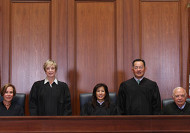Article from: www.thenewspaper.com/news/43/4361.asp
3/17/2014
California Supreme Court Orders Red Light Camera Warnings
California Supreme Court rules each red light camera intersection must have its own thirty-day warning period, but refuses to enforce it.
 Photo ticketing programs in California must provide a thirty-day waiting period at each individual red light camera location before issuing tickets. That finding, handed down Thursday by the state Supreme Court, came as a big surprise to municipalities that believe their legal duties are done when they have a warning period at the very start of the ticketing program, not when other locations are added -- sometimes years later. The ruling was not a victory for motorists as the justices went out of their way to minimize the impact of their finding by ensuring it could not be used as a defense against improperly issued citations or a reason to compel refunds.
Photo ticketing programs in California must provide a thirty-day waiting period at each individual red light camera location before issuing tickets. That finding, handed down Thursday by the state Supreme Court, came as a big surprise to municipalities that believe their legal duties are done when they have a warning period at the very start of the ticketing program, not when other locations are added -- sometimes years later. The ruling was not a victory for motorists as the justices went out of their way to minimize the impact of their finding by ensuring it could not be used as a defense against improperly issued citations or a reason to compel refunds.
"Unlike the Court of Appeal, we conclude that the public announcement and warning requirements apply to each installation of such a device," Justice Joyce L. Kennard wrote for the unanimous court. "We nevertheless affirm the Court of Appeal, which upheld defendant's conviction, because, like that court, we reject defendant's argument that compliance with the statute's requirement of a 30-day period of warning notices is a precondition to issuing a valid citation for a red light traffic law violation."
The court further limited the usefulness of its finding by opting not to publish the decision, which prevents the decision from being cited as precedent at trial. The ruling only affects Steven E. Gray, who brought the case after Redflex Traffic Systems of Australia mailed him a ticket after photographing his car allegedly driving through the red light at the intersection of Washington Boulevard and La Cienega Boulevard in Culver City.
Gray pointed out that when Redflex installed the first cameras in Culver City in 1998, it made an announcement and held a thirty-day waiting period in accordance with the law. When it installed the next set of cameras in 2006, and again in 2008, there was no waiting period. The camera that mailed Gray a ticket was installed in 2008 without the warning. He argued that this did not fulfill the requirements of state law.
"Prior to issuing citations under this section, a local jurisdiction utilizing an automated traffic enforcement system shall commence a program to issue only warning notices for 30 days," Section 21455.5(b) states. "The local jurisdiction shall also make a public announcement of the automated traffic enforcement system at least 30 days prior to the commencement of the enforcement program."
Culver City insisted that "system" referred to the entire citywide network of red light cameras. The justices found this interpretation did not make sense with the way the term is used in other sections of the statute, and that "system" must refer to the equipment at a particular intersection.
"Public policy supports that conclusions," Justice Kennard wrote. "The warning notices required by section 21455.5(b) serve to inform the drivers who frequently use a particular intersection that the city's enforcement method has changed. We see no justification for a rule requiring warnings to drivers who frequently use one intersection, but not to drivers who frequently use a different intersection."
Because the legislature did not specify a penalty for failure to comply with this law, the court refused to enforce its finding.
A copy of the ruling is available in a 200k PDF file at the source link below.
Source: California v. Gray (California Supreme Court, 3/13/2014)
Permanent Link for this item
Return to Front Page
 Photo ticketing programs in California must provide a thirty-day waiting period at each individual red light camera location before issuing tickets. That finding, handed down Thursday by the state Supreme Court, came as a big surprise to municipalities that believe their legal duties are done when they have a warning period at the very start of the ticketing program, not when other locations are added -- sometimes years later. The ruling was not a victory for motorists as the justices went out of their way to minimize the impact of their finding by ensuring it could not be used as a defense against improperly issued citations or a reason to compel refunds.
Photo ticketing programs in California must provide a thirty-day waiting period at each individual red light camera location before issuing tickets. That finding, handed down Thursday by the state Supreme Court, came as a big surprise to municipalities that believe their legal duties are done when they have a warning period at the very start of the ticketing program, not when other locations are added -- sometimes years later. The ruling was not a victory for motorists as the justices went out of their way to minimize the impact of their finding by ensuring it could not be used as a defense against improperly issued citations or a reason to compel refunds.